
Composting toilet second story
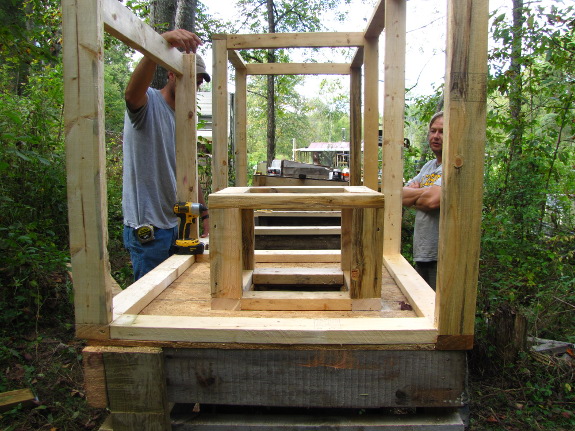
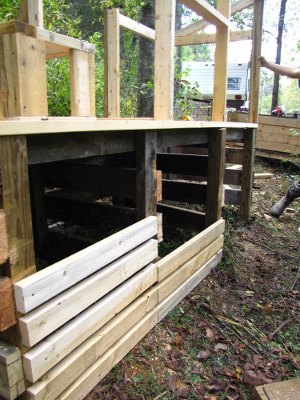 When Mark got home, he had
some great suggestions for making the
first phase of our composting toilet system more ergonomic.
When Mark got home, he had
some great suggestions for making the
first phase of our composting toilet system more ergonomic.
His biggest concern was
that my straw bales on the downhill side would drift out of place (or
get torn apart when Lucy heard a mouse inside), resulting in a
landslide of humanure.
That sounded pretty
terrible, so I was glad Mark also had a suggested solution --- screwing
some two by fours on as a temporary retaining wall between the compost
and the straw bales. By using screws, it'll be easy to remove the
wall in two years once the bin has filled and mellowed and is ready to
hit the garden.
While he was at it,
Bradley added a shorter wall for the sawdust storage compartment to
make sure we don't lose too much of our precious carbon, while still
making it easy to scoop out bucketsful to bring upstairs.
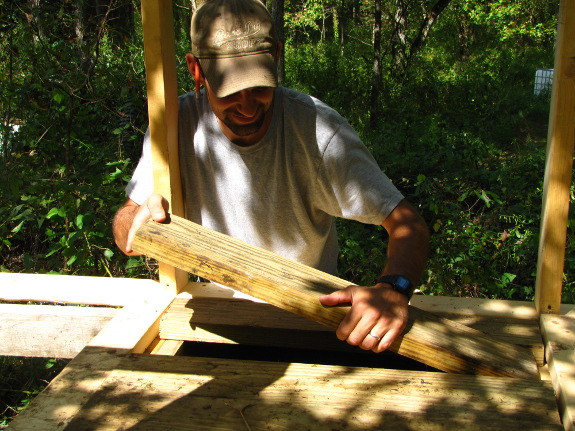
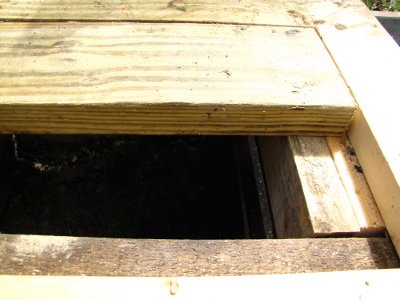 "And about that sawdust
storage compartment," Mark added. "How exactly are we going to
get sawdust into it if there's a floor over top?"
"And about that sawdust
storage compartment," Mark added. "How exactly are we going to
get sawdust into it if there's a floor over top?"
Bradley had an ingenious
solution there, turning the central floor into a trap door by setting
decking boards on a ledge of other boards. The floor feels very
solid when you walk on it, but the boards are easy to move to the side
so we can pour sawdust directly into the central bin.
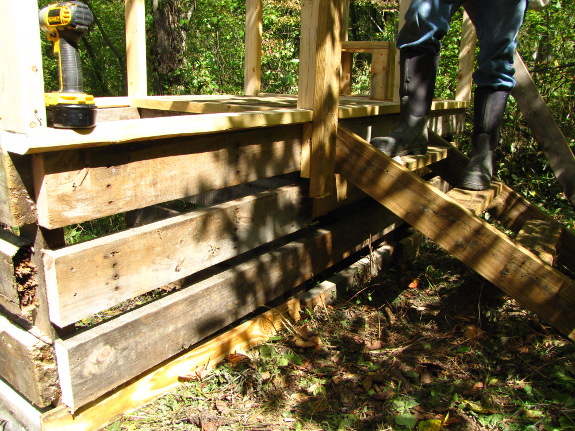
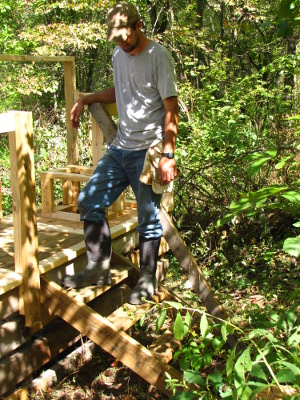 Mark's last concern was that
rain might cause runoff to roll down the hill during heavy storms and
wash under the compost bins, causing lots of seepage. A lip on
the uphill side of the compartments should serve to channel the water
away.
Mark's last concern was that
rain might cause runoff to roll down the hill during heavy storms and
wash under the compost bins, causing lots of seepage. A lip on
the uphill side of the compartments should serve to channel the water
away.
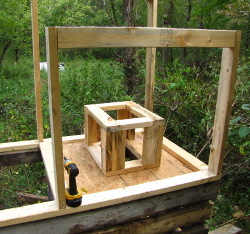
Meanwhile, Bradley was
busy putting the second story on top of the composting bins. He
built a beautiful set of steps without risers (just like the
second set he made for Mark's porch) and constructed a very
sturdy box for us to sit on. (We'll close in the sides with
plywood once we rustle some up.)
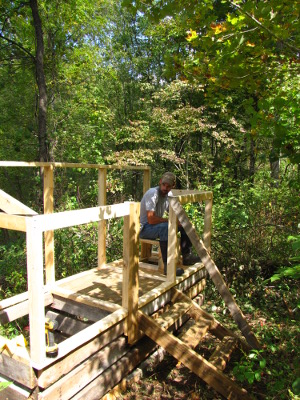 To keep the open air effect
that Mark and I both enjoy, Bradley chose to make a low privacy wall in
the front and a slightly higher wall in the back. The composting
toilet faces away from our core homestead, so there's next to no chance
someone will accidentally walk around to the front while doing other
tasks.
To keep the open air effect
that Mark and I both enjoy, Bradley chose to make a low privacy wall in
the front and a slightly higher wall in the back. The composting
toilet faces away from our core homestead, so there's next to no chance
someone will accidentally walk around to the front while doing other
tasks.
Mark had the great idea
to pin a brown tarp up around the walls rather than using plywood since
the tarp will likely last longer. We don't have the tarp yet ---
that's on the shopping list.
What you also can't see
(because it doesn't yet exist) is the roof. Bradley's going to
make that free-standing and large enough to keep the straw bales in the
back dry. We've got enough scrap tin lying around that we should
be able to build the roof without any extra purchased supplies.
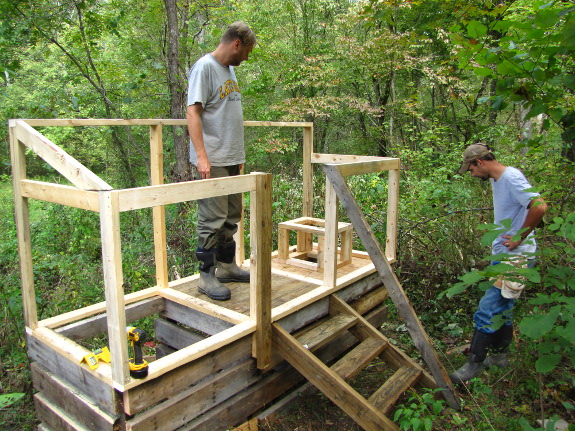
Here's the second story
so far. We hope to finish it next week around the same time the
driveway dries up enough to allow us to haul in sawdust and
straw. I think I'm going to have to put "anticipating using your
open air composting toilet for the first time" onto my list of
characteristics that brand the permaculture
redneck.
Want more in-depth information? Browse through our books.
Or explore more posts by date or by subject.
About us: Anna Hess and Mark Hamilton spent over a decade living self-sufficiently in the mountains of Virginia before moving north to start over from scratch in the foothills of Ohio. They've experimented with permaculture, no-till gardening, trailersteading, home-based microbusinesses and much more, writing about their adventures in both blogs and books.
Want to be notified when new comments are posted on this page? Click on the RSS button after you add a comment to subscribe to the comment feed, or simply check the box beside "email replies to me" while writing your comment.

I saw a composting toilet on a second floor on the University of British Columbia's in the C.K. Choi building that my professor had built. They just offset the toilets from one floor to the next and have the composting system in the basement. Obviously not what your building but it can be done.
http://en.wikipedia.org/wiki/C.K.Choi_Building
In finding the link I was disheartened to see they stopped using the composting system last year and started shipping it to the landfill...
In regards to drainage: Digging a shallow trench (similar to what is done when camping) on the uphill side to help the water drain around the toilets may be an option to consider if you don't want too many nutrients to leach downhill.
Brian --- That's funny --- I was thinking about that exact design as being a possibility while out weeding after reading Heath's comment. Very sad that the composting system was ended.
Bradley suggested a similar ditch --- I think you're both right, that it would be a good extra insurance against runoff!
Heath --- That's pretty funny.
BeninMA --- In Farmers of Forty Centuries, the author writes about roadside outhouses built specifically to "trap" organic matter from travelers. Even though it's not humanure, I was amazed by the amount of money the author of Ten Acres Enough spent on organic matter. Clearly, other cultures and times have known the value much more than we do now. Good to add your samurai data point!
I'm looking forward to seeing how this works for you. We are considering options without a drain field. And a system like this is in consideration.
I don't understand a tarp lasting longer than plywood though. And it may even cost more. Maybe I'm missing something.
Best of luck with success!
Arthur --- Good idea to wait and learn from our mistakes.
I'm not sure I agree on the tarp either, but Mark and Bradley seemed to think it made sense, so I figured it wouldn't hurt.
Harmony --- I'd love to hear more about the design of your composting toilet!
I read and enjoyed The Humanure Handbook. Even though our design is a lot different from his, I'm still taking Jenkins' experiences into account.
We don't mind going back to the house to wash our hands --- that's what we do now with the outhouse, and it's no big deal. I might eventually do some rainwater collection and a sink just for summer hand-washing, but that would be icing on the cake.
Nicki --- I'm not sure what you're asking with your first question --- do you mean when you apply the compost to plants later or whether the structure will affect nearby plants? If the latter, I'd say it would be a lot like a compost pile --- you'd see more growth right beside it. People often plant flowers in spots like that so they don't have to worry about contamination, but can enjoy seeing the growth.
You never want to put any kind of manure near your well (and that includes pastures of all sorts too). Generally, I believe, the rule of thumb is at least 50 feet away, or at least 100 feet away if you put the manure uphill of the well. (It can run further downhill than uphill.) The same rules apply if you're locating a composting toilet or pasture near a body of water.